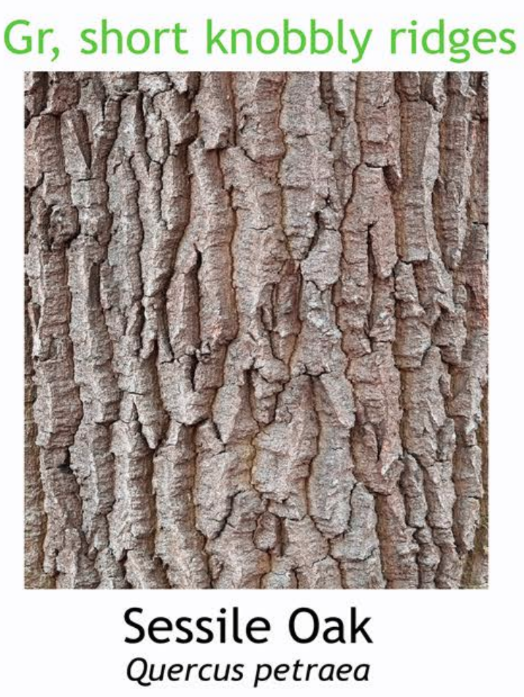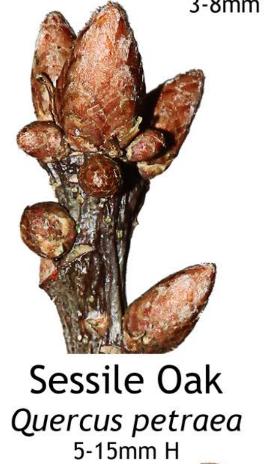A native deciduous tree species in Ireland, commonly found in woodlands, forests, and upland areas.
Recognising the Sessile Oak Tree:
-
Leaves: The leaves of the Sessile Oak tree are alternate, lobed, and have short stalks. They are dark green in colour and have rounded lobes with no or very short leaf stalks.
-
Bark: The bark of the Sessile Oak tree is dark grey to blackish and develops deep fissures and ridges with age. It has a rough texture and becomes more rugged over time.
-
Acorns: Sessile Oak trees produce small acorns that are borne directly on the twigs without stalks. The acorns have distinctive cupules with tightly overlapping scales.
-
Shape: Sessile Oak trees have a broad, spreading canopy with sturdy branches and a straight, tall trunk. They can grow to significant heights and are often characterised by their imposing presence in the landscape.
-
Habitat: Sessile Oak trees are commonly found in a variety of habitats, including woodlands, forests, upland areas, and mixed-species stands. They prefer moist, well-drained soils and are often associated with other broadleaf tree species.



5 Interesting Facts about the Sessile Oak Tree:
-
Habitat Preference: Sessile Oak trees are more tolerant of acidic soils and upland conditions compared to their close relative, the Pendunculate Oak. As a result, they are commonly found in upland areas and woodlands with poor soil quality.
-
Hybridization: Sessile Oak trees can hybridise with Pendunculate Oak trees where their ranges overlap, resulting in intermediate forms known as "Durham Oaks" or "Quercus x rosacea." These hybrids exhibit characteristics of both parent species.
-
Wood Quality: Sessile Oak wood is highly valued for its strength, durability, and attractive grain pattern. It is used in a wide range of applications, including furniture making, flooring, joinery, cabinetry, cooperage (barrel making), and construction.
-
Wildlife Habitat: Sessile Oak trees provide valuable habitat and food for a wide range of wildlife species. Birds such as jays, woodpeckers, and nuthatches feed on the acorns, while mammals such as squirrels, deer, and wild boar may also browse on the foliage and feed on the acorns.
-
Historical Significance: Sessile Oak trees have played a significant role in human history and culture. They have been revered as symbols of strength, endurance, and wisdom in folklore, mythology, and literature. Oak trees were also used historically for shipbuilding, timber construction, and as a source of tannin for leather production.
Uses of the Sessile Oak Tree:
-
Timber: Sessile Oak wood is highly valued for its strength, durability, and attractive grain pattern. It is used in a wide range of applications, including furniture making, flooring, joinery, cabinetry, cooperage (barrel making), and construction.
-
Wildlife Habitat: Sessile Oak trees provide valuable habitat and food for a variety of wildlife species. Their presence enhances habitat complexity and supports biodiversity in woodlands, forests, and upland areas.
-
Cultural and Recreational Use: Sessile Oak trees are valued for their aesthetic and cultural significance. They are often planted in parks, gardens, and landscapes as specimen trees, shade trees, and focal points. They also provide recreational opportunities for activities such as hiking, picnicking, and wildlife watching.
Contribution to Biodiversity:
-
Habitat Provider: Sessile Oak trees contribute to biodiversity by providing habitat and food for a wide range of wildlife species. Their presence enhances habitat complexity and supports populations of birds, mammals, insects, and other organisms in woodlands, forests, and upland areas.
-
Nutrient Cycling: Sessile Oak trees play a role in nutrient cycling by absorbing carbon dioxide from the atmosphere and releasing oxygen through photosynthesis. They also cycle nutrients through their leaves, branches, and roots, contributing to soil fertility and ecosystem productivity.
-
Soil Health: Sessile Oak trees help maintain soil health and stability through their extensive root systems, which prevent erosion, improve soil structure, and promote water infiltration and retention. Their presence contributes to the overall health and resilience of woodland and forest ecosystems.
In summary, the Sessile Oak tree is recognisable by its lobed leaves, small acorns, and imposing stature. It holds cultural significance, provides valuable resources for wildlife, and contributes to biodiversity and ecosystem health in Ireland's woodlands, forests, and upland areas. Additionally, it serves as a source of timber, supports recreational activities, and enhances habitat complexity in natural ecosystems.
Images taken from the beautiful posters created by Phil Barnett and you can download these and/or purchase other great designs from his online shop.
